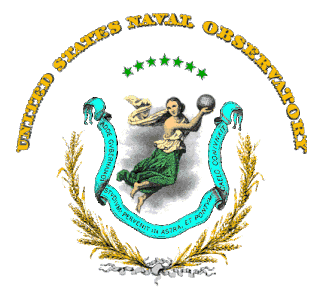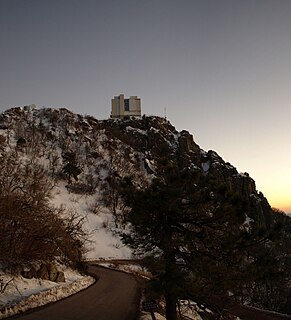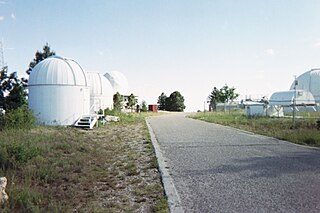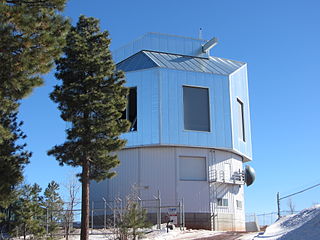Related Research Articles

The United States Naval Observatory (USNO) is one of the oldest scientific agencies in the United States, with a primary mission to produce positioning, navigation and timing for the United States Navy and the United States Department of Defense.

Lowell Observatory is an astronomical observatory in Flagstaff, Arizona, United States. Lowell Observatory was established in 1894, placing it among the oldest observatories in the United States, and was designated a National Historic Landmark in 1965. In 2011, the Observatory was named one of "The World's 100 Most Important Places" by TIME. It was at the Lowell Observatory that the dwarf planet Pluto was discovered in 1930 by Clyde Tombaugh.

Steward Observatory is the research arm of the Department of Astronomy at the University of Arizona (UA). Its offices are located on the UA campus in Tucson, Arizona (US). Established in 1916, the first telescope and building were formally dedicated on April 23, 1923. It now operates, or is a partner in telescopes at five mountain-top locations in Arizona, one in New Mexico, one in Hawaii, and one in Chile. It has provided instruments for three different space telescopes and numerous terrestrial ones. Steward also has one of the few facilities in the world that can cast and figure the very large primary mirrors used in telescopes built in the early 21st century.

The Cerro Tololo Inter-American Observatory (CTIO) is an astronomical observatory located on Cerro Tololo in the Coquimbo Region of northern Chile, with additional facilities located on Cerro Pachón about 10 kilometres (6.2 mi) to the southeast. It is within the Coquimbo Region and approximately 80 kilometres (50 mi) east of La Serena, where support facilities are located. The site was identified by a team of scientists from Chile and the United States in 1959, and it was selected in 1962. Construction began in 1963 and regular astronomical observations commenced in 1965. Construction of large buildings on Cerro Tololo ended with the completion of the Víctor Blanco Telescope in 1974, but smaller facilities have been built since then. Cerro Pachón is still under development, with two large telescopes inaugurated since 2000, and one in the early stages of construction.

Perkins Observatory is an astronomical observatory in Delaware, Ohio. It is owned and operated by Ohio Wesleyan University.
Frank Kelley Edmondson was an American astronomer.

The MMT Observatory (MMTO) is an astronomical observatory on the site of Fred Lawrence Whipple Observatory. The Whipple observatory complex is located on Mount Hopkins, Arizona, US in the Santa Rita Mountains. The observatory is operated by the University of Arizona and the Smithsonian Institution, and has a visitor center in nearby Amado, Arizona. The MMTO is the home of the MMT, which has a primary mirror 6.5 m in diameter. The name comes from the six smaller mirrors originally used before the single primary mirror was installed in 1998. The primary mirror has a special lightweight honeycomb design made by the University of Arizona's Steward Observatory Mirror Laboratory. The MMT is housed in a building which allows the walls and roof around the telescope to be completely rolled back, allowing it to cool down very quickly in order to improve observation.

Mount Laguna Observatory (MLO) is an astronomical observatory owned and operated by San Diego State University (SDSU). The telescope was operated in partnership with the University of Illinois at Urbana-Champaign (UIUC) until 2000. MLO is located approximately 75 kilometers (47 mi) east of downtown San Diego, California (USA) on the eastern edge of the Cleveland National Forest in the Laguna Mountains on the SDSU Astronomy Campus near the hamlet of Mount Laguna. MLO was dedicated on June 19, 1968, seven years after SDSU's Department of Astronomy became an independent academic department of SDSU's College of Sciences. The dedication took place during the 1968 summer meeting of the Astronomical Society of the Pacific. Currently SDSU is working with University of Kansas (KU), and UNC Chapel Hill on various projects.

The James Richard Jewett Observatory is an astronomical observatory owned and operated by Washington State University. It is located in Pullman, Washington (US). It houses the largest refracting telescope in the state of Washington. The 12-inch lens was originally ground and polished between 1887 and 1889 by Alvan Clark & Sons for an amateur astronomer, who died before the telescope could be assembled. The lens was put into storage, and was purchased by the university when it came up for auction in the 1950s. Its present dome was dedicated in 1953 and it is named after the father of a supporter of the observatory, Mr. George Jewett of Spokane.

Chamberlin Observatory is an astronomical observatory owned and operated by the University of Denver. It is located in Denver, Colorado (US) in Observatory Park. It is named for Humphrey B. Chamberlin, a Denver real estate magnate who pledged $50,000 in 1888 to build and equip the facility.

Vega–Bray Observatory is an astronomical observatory owned and operated by Astronomers Inn located on a small hill overlooking the San Pedro River Valley, just east of Benson, Arizona (USA). Founded in 1990 by Max Bray, an optician and Dr. Eduardo Vega, a pathologist, it is home to the Hoot–Vega Radio Telescope.

Stull Observatory is an astronomical observatory owned and operated by Alfred University. Named after Dr. John Stull, who helped establish the observatory in 1966, it is located in Alfred, New York (USA). It is notable for housing seven independently housed telescopes ranging in size from 8 to 32 inches. The largest, the Austin-Fellows 32 inch Newtonian Reflector is tied with the Vassar College Class of 1951 Observatory for the rank of second largest optical telescope in New York state after the 40 inch telescope at SUNY Oneonta College Observatory. Telescopes at the observatory are regularly opened to the public. The observatory is also used for those pursuing a minor in astronomy or a concentration in astrophysics.

C.E.K. Mees Observatory is an astronomical observatory in Bristol, New York, owned and operated by the University of Rochester. The observatory is named after C. E. Kenneth Mees, "in honor of his pioneering work in the development of sensitive photographic emulsions for use in astronomy."

Warren Rupp Observatory is an astronomical observatory owned and operated by Richland Astronomical Society. Built in 1985, it is located on the Friendly House Hidden Hollow Camp south of Mansfield, Ohio (USA).

Anderson Mesa Station is an astronomical observatory established in 1959 as a dark-sky observing site for Lowell Observatory. It is located at Anderson Mesa in Coconino County, Arizona (USA), about 12 miles southeast of Lowell's main campus on Mars Hill in Flagstaff, Arizona.

Mount Lemmon Observatory (MLO), also known as the Mount Lemmon Infrared Observatory, is an astronomical observatory located on Mount Lemmon in the Santa Catalina Mountains approximately 28 kilometers (17 mi) northeast of Tucson, Arizona (US). The site in the Coronado National Forest is used with special permission from the U.S. Forest Service by the University of Arizona's Steward Observatory, and contains a number of independently managed telescopes.

The Lowell Discovery Telescope (LDT), formerly the Discovery Channel Telescope (DCT), is a 4.3 m (170 in) aperture telescope owned and operated by Lowell Observatory. The LDT was built at a dark sky site in the Coconino National Forest near Happy Jack, Arizona. Happy Jack is located at an elevation of 2,360 m (7,740 ft) and is approximately 65 km (40 mi) south-south-east of Flagstaff. The project was initially a partnership between Discovery Communications and Lowell Observatory. The research partnerships have been extended to include Boston University, The University of Maryland, The University of Toledo, and Northern Arizona University. The telescope cost $53 million. It significantly augments Lowell Observatory's observational capability and enables pioneering studies in a number of important research areas.

The United States Naval Observatory Flagstaff Station (NOFS), is an astronomical observatory near Flagstaff, Arizona, US. It is the national dark-sky observing facility under the United States Naval Observatory (USNO). NOFS and USNO combine as the Celestial Reference Frame manager for the U.S. Secretary of Defense.

The Peach Mountain Observatory (PMO) is an astronomical observatory owned and operated by the University of Michigan (UM). It is located near the village of Dexter, Michigan (USA), about 20 kilometers (12 mi) northwest of Ann Arbor. It was opened in 1955, and is used for research, instruction, and amateur observing.

The Portage Lake Observatory (PLO) was an astronomical observatory owned and operated by the University of Michigan (UM). It was located near the village of Dexter, Michigan (USA), about 20 kilometers (12 mi) northwest of Ann Arbor. Construction at the site began in 1948, and the facility was closed in 1975.
References
- "Braeside Observatory homepage". Welcome to Braeside Observatory. Retrieved October 3, 2008.
- "Braeside Observatory homepage". Welcome to the Arizona State University Braeside Observatory. Retrieved December 12, 2005.
- "Braeside Observatory previous homepage" . Retrieved August 12, 2007.